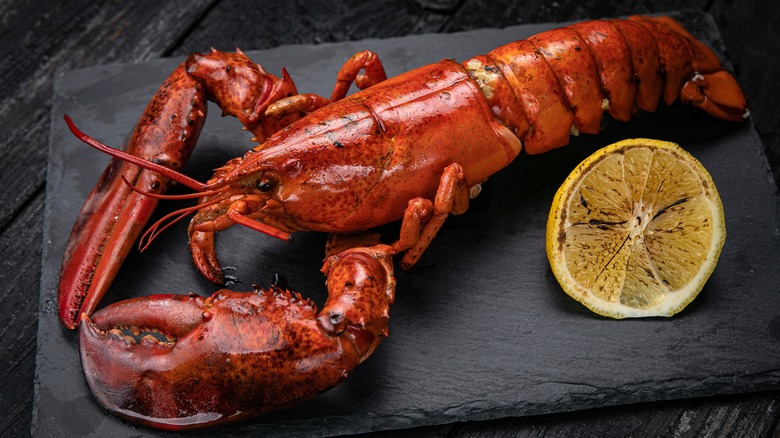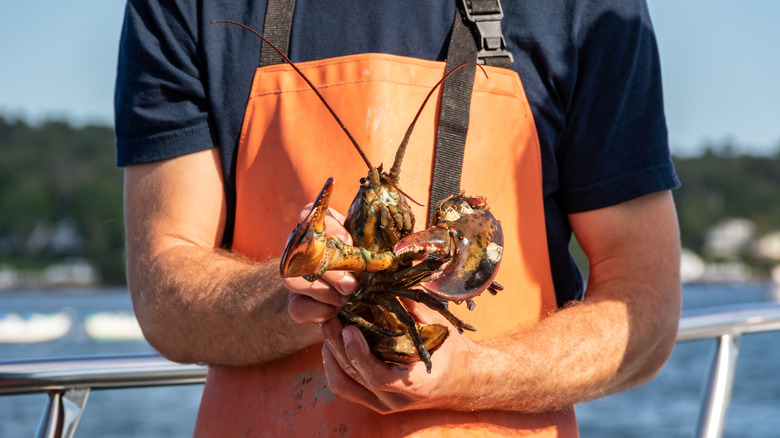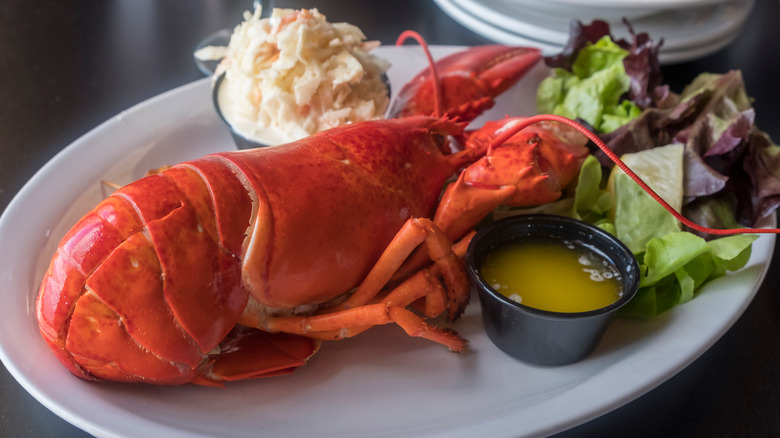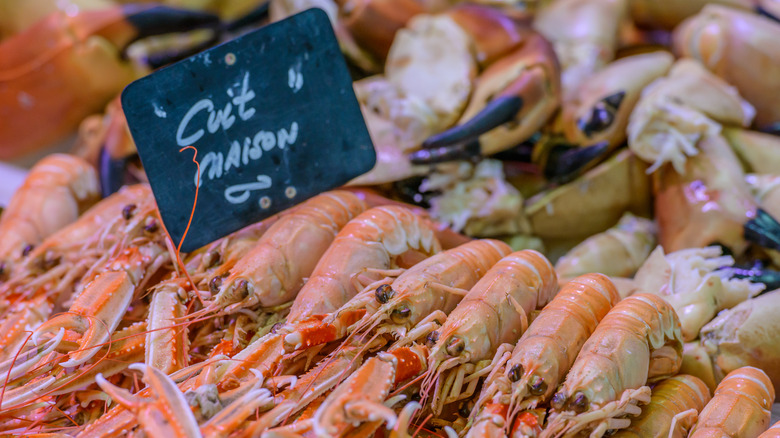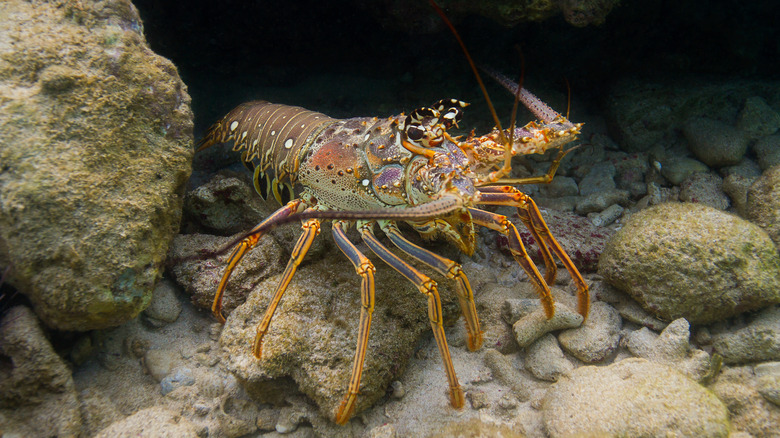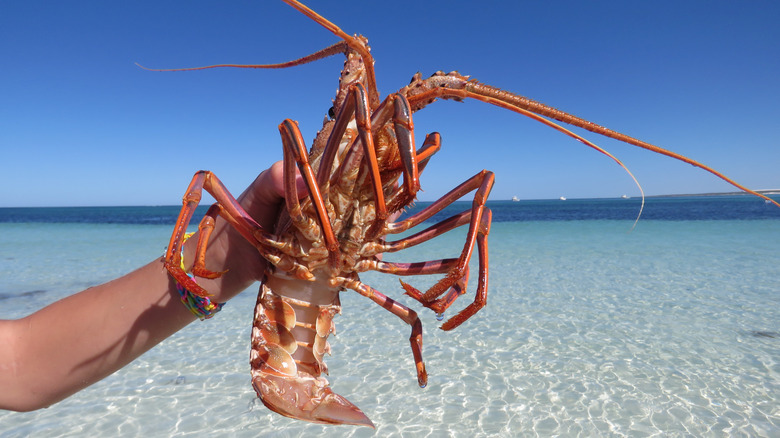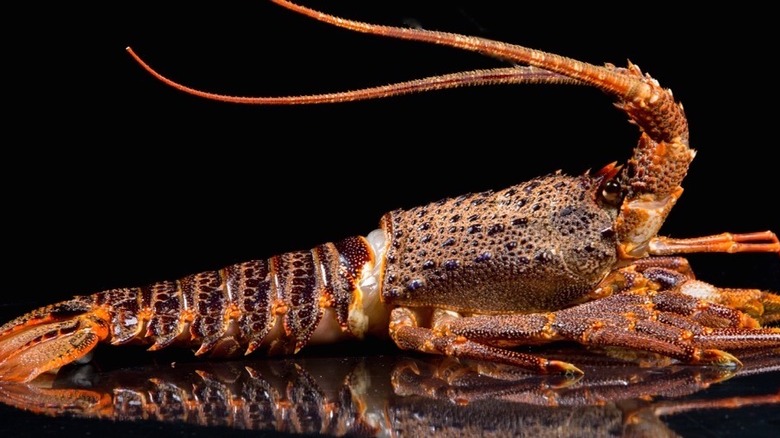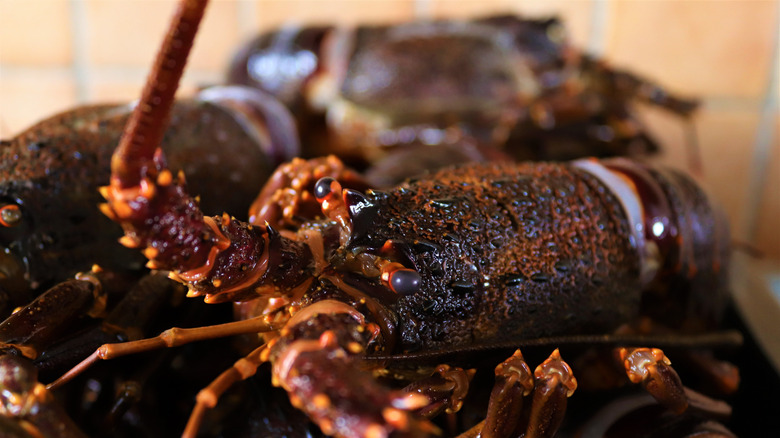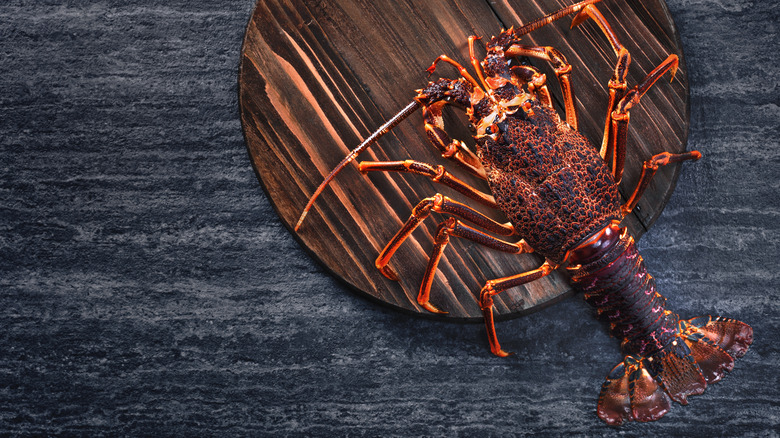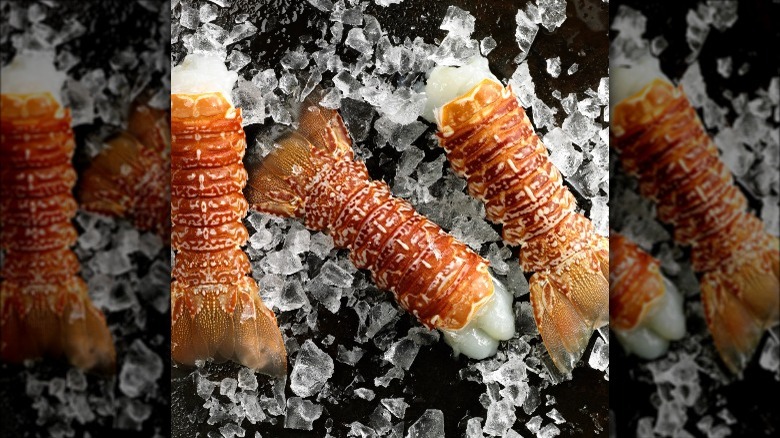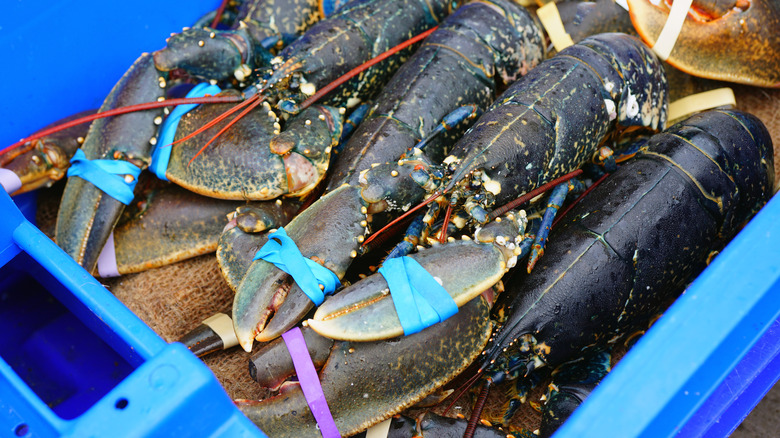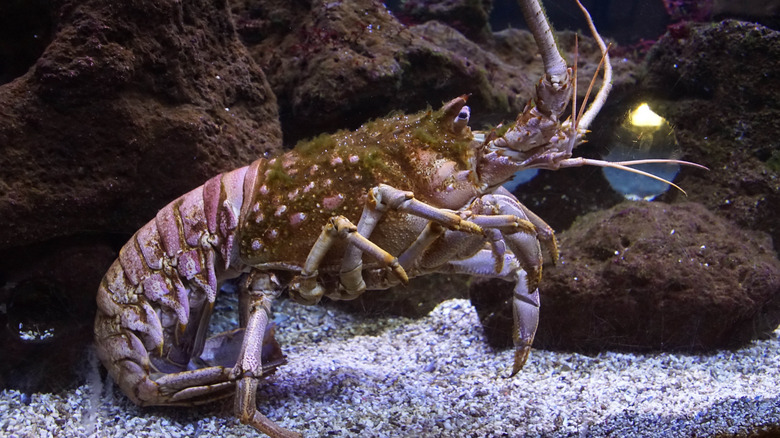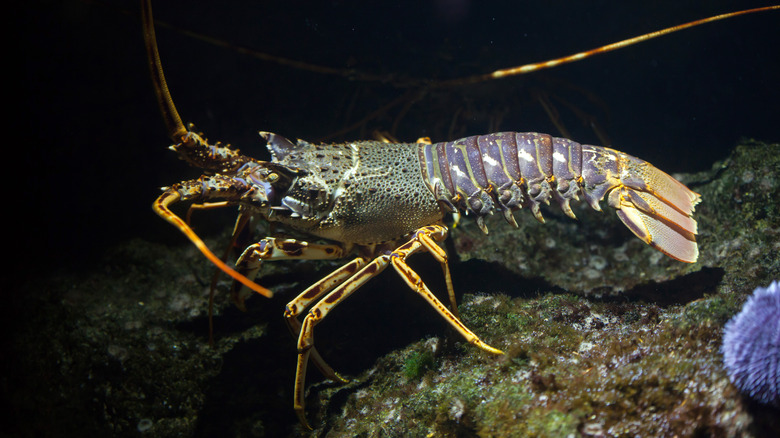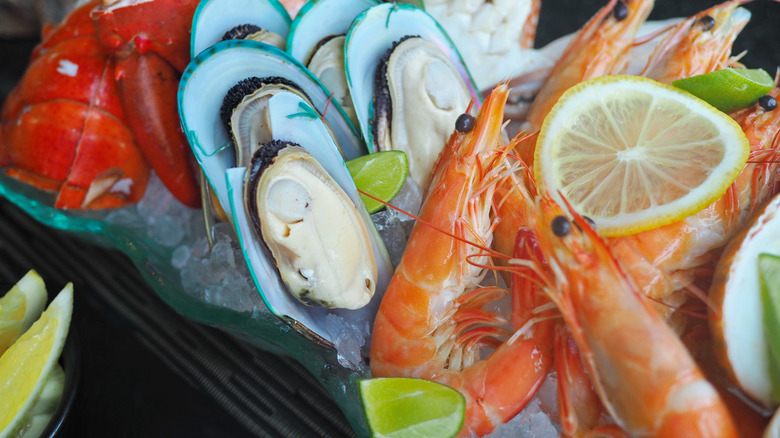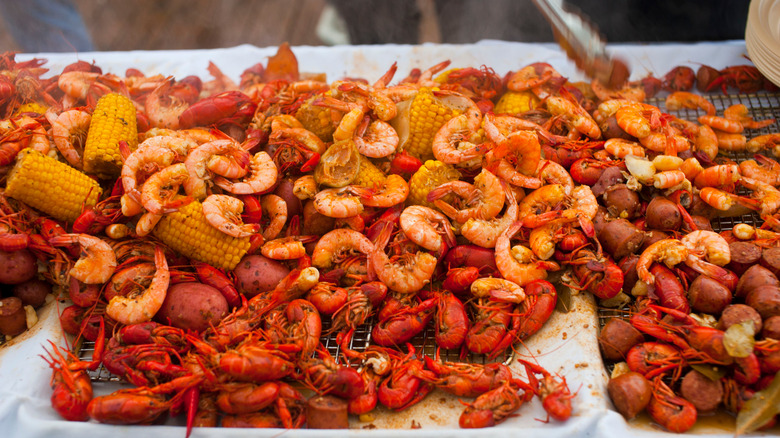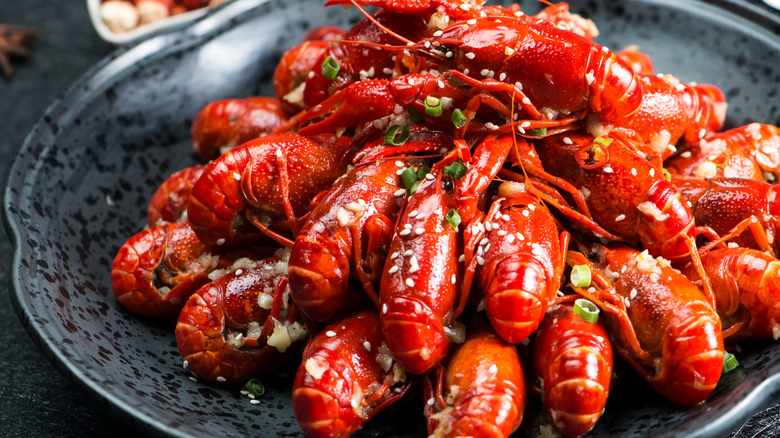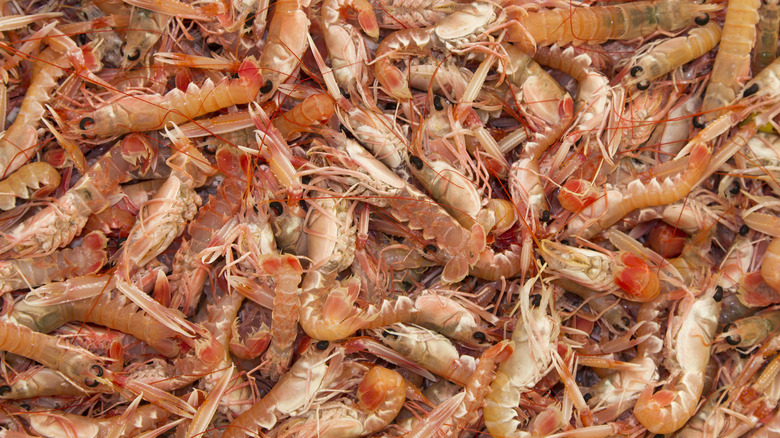16 Types Of Lobster And How To Cook Them
Delicate lobster meat is coveted around the globe, and there is a broad assortment of options that may leave enthusiasts pleasantly surprised. References to fresh Maine catches and opulent surf and turf steak and lobster dinners estimate a universal reverence for the crustacean while phenomenal "cotton-candy lobster" discoveries leave behind a world struck with universal aquatic awe.
Oddly enough, lobster wasn't always a prestigious menu item. In 18th century America, it was the antithesis of a "high-class dinner" and even required laws to spare servants the burden of consuming lobster more than twice a week (via Ocean Conservancy). Times have certainly changed. In 2019, the U.S. fished over 200 million pounds of American lobster (via Statista).
American lobster may feel like an obvious choice, especially in a country that puts the meaty variety on a pedestal. However, the world of lobster is incredibly diverse. Different shapes, colors, sizes, and pokey features barely scratch the surface. Ocean waters accommodate cold-water lobsters, warm-water lobsters, and acknowledge nearby lobster relatives that don't live in saltwater at all. All are unique, immensely delicious, and tied to boundless culinary creations. Here are 16 different types of lobsters (and related crustaceans) with assorted tips on how to cook each prized shellfish.
American lobster
This New England staple and the official state crustacean of Maine is prevalent throughout the vast Gulf of Maine, but spans the entire northeast Atlantic coast in cold-water temperatures that can reach 60 F at summer's peak (via Maine.gov). A myriad of colorful red, brown, green, and blue spotting adorn the world's largest crustacean by weight. So, what makes this lobster variety unique and so coveted on U.S. coastal reefs? Well, beyond its sizeable tail, the American lobster features two characteristic claws that deliver generous amounts of succulent meat (via Oceana).
You can't go wrong with enjoying the meat straight from the shell with a side of lemon and drawn butter. Chef Gordon Ramsay recommends killing the lobster before cooking for two minutes in a pot of salted boiling water, removing the bright red shell, and coveting the pristine lobster meat before further transformation (via Popsugar).
Lobster rolls are another an obvious choice when it comes to preparing American lobster. The perfect balance of valuable lobster chunks and a simple toasted roll breaches a fancy fine-dining lobster gap with just the right amount of sea breeze to match the catch's brininess. According to Luke Holden of international fast casual chain Luke's Lobster, the ideal lobster roll relies on optimal freshness and allowing the sweet and tender meat to shine without an overabundance of mayonnaise (via The New York Times). Opt for a butter-toasted top-split or brioche roll, lobster meat chunks judiciously dressed in melted butter, chopped chives, lemon zest, and an aioli drizzle for an extra layer of richness.
Canadian lobster
Canadian lobster is not unlike its Maine counterpart. In fact, it's actually the same species. Canada's large and double-clawed variety is also bound to the north Atlantic Ocean, and although these two regional lobsters are similar, it's worth differentiating the two solely based on geographic location. Unsurprisingly, Atlantic Ocean temperatures drop the further north you travel, so Canadian lobsters are bred in colder temperatures and grow to even greater sizes (via Maine Lobster Now).
When it comes to cooking Canadian lobster, similar preparation rules apply. Boiling, steaming, or even grilling accentuates the lobster's natural sweetness, and fruity olive oil or melted butter coats the fresh seafood in an unctuous blanket. Per The New York Times, try topping crisp and lightly dressed salad greens with seasoned lobster chunks and garnish with sliced avocado. If you're feeling really fancy, top with segmented orange gems and an extra drizzle of olive oil.
If butter-dressed lobster feels predictable, take note from David Chang's "Ugly Delicious" adventures at Toronto's Fishman Lobster Clubhouse, where he enjoyed the dreamy 50-pound Lobster Mountain (via Eater). Impressive Canadian lobster is expertly battered and fried to crispy perfection and built into a tower the size of a grand croquembouche centerpiece. Try a more approachable version at home by coating raw lobster chunks in a batter of flour, rice flour, and soda water and frying in hot oil before pairing with an aromatic ginger and scallion sauce. Tower construction is optional.
Norway lobster
A crustacean with many names, the Norway lobster (also known as Dublin Bay Prawn or langoustine) is a European seafood delicacy. The little sea creature resembles both an American lobster — with two claw-like extremities — and a massive pale orange-pink shrimp with a hard outer shell. Bountiful across both the Western Mediterranean Sea and Northwest Atlantic, langoustine reaches as far south as Morocco and as far north as Lofoten, Norway (via Institute of Marine Research).
Because of its vast scope, there are lots of preparation styles that employ regional cooking techniques and flavors. A Washington Post feature on Scotland's Inner Hebrides highlights local hotel seafood and langoustine plates, while remote Faroe Island vacationers aspire towards langoustine dinners straight from nearby waters. For a super easy preparation, try langoustine "a la plancha" — a Spanish cooking method that introduces an oil-less hot griddle. Heat an indoor grill, outdoor grill, griddle pan, or cast-iron skillet over medium-high heat and sear the shell-on langoustine on each side for about two minutes, until the meat is fully cooked. Remove from the pan and drizzle liberally with extra-virgin Spanish olive oil, sprinkle with flaky salt, and serve with lemon and lots of bread.
Spanish culinary royalty José Andrés has some can't-miss tips to peel and eat langoustine with passionate precision and "respect for the goodness of the sea" (via Food and Wine). Per Andrés, a pinch at the bottom to remove the tail and an index finger to separate the head from the body is the most efficient and effective shelling strategy.
Caribbean spiny lobster
The first warm-water lobster dweller on this global crustacean tour, Caribbean spiny lobsters are uniquely spiked and take shelter in shallow southern ocean waters. Most prevalent throughout the Caribbean, spiny lobsters have characteristic forward-pointing spines, a reddish-brown color, and antennae, while lacking large front claws (via NOAA Fisheries). A more sustainable seafood choice under U.S. regulations, Caribbean spiny lobsters can get up to 15 pounds and are highly prized for an overabundance of firmer tail meat.
In addition to a firmer texture, Caribbean spiny lobsters are a little less sweet than their Maine counterparts, and a salty warm water kiss adds extra brininess (via Caribbean Castaways). Tail meat can be used in Ina Garten's Lobster Cobb salad recipe, pasta sauces, bisque, or lobster Thermidor. But the most common spiny lobster preparation is grilling (via The Spruce Eats). Halve the lobster tails lengthwise to expose the raw meat, season with salt, pepper, and spices, and grill until the meat is cooked through. A melted garlic butter baste finishes the charred lobster with an extra layer of richness.
Western rock lobster
Keeping to the name, western rock lobster is a spiny lobster variety native to Australia's western coast. Just like Caribbean spiny lobster, hundreds of forward-pointing spines and two large antennae are distinct features (via Western Rock Lobster). Shallow waters along the coast of Perth and Geraldton shelter most of the Western rock lobster population. Australia's Western Rock Lobster Fishery is one of the most sustainable fisheries in the world, receiving international recognition for preservation standards.
Cooking techniques for western rock lobster are practically limitless, and Geraldton's Shore Leave Festival sheds light on some of Australia's go-to preparations. Ticketed festival events showcase long dinner tables studded with lobster, seafood platters, and epic oceanside views. But if you can't make it in person, take note from festival antics and try adding lobster chunks to a seafood paella or throw them straight on the grill (via Instagram). Aussie chef Curtis Stone concurs with the traditional grilling approach and tops the lobster halves with homemade garlic-parsley butter (via Saveur). All preparations are best enjoyed with a glass of wine.
Tristan lobster
Tristan lobsters travel a long way to reach fish market mongers. Hailing from Tristan da Cunha, a remote chain of islands in the South Atlantic Ocean, the incredibly rare lobster type only sees island visitors nine times a year to harvest the coveted pearl-like meat (via Wegmans). The islands are ethereal, with tall mountain peaks, gorgeous crystal waters, and active volcano excitement on the main Tristan da Cunha 24-square mile island (via The New York Times). This trip is only made a handful of times for good reason. The British Overseas Territory lacks an airport, so water transportation is the only option and the journey lasts about one week by boat from South Africa's Cape Town.
Cooking Tristan lobster is a genuine honor, stemming from the lobster's isolated location and sheer rareness. According to grocery chain Wegmans, which supplies limited amounts of Tristan lobster, grilling, baking, or roasting the exceptionally sweet tails are all recommended.
Southern rock lobster
Southern Hemisphere crustaceans are plentiful among stunning warm coastal bays. The Southern rock lobster is yet another spiny lobster type scattered throughout rocky New Zealand and southern Australian coastlines (via Fiordland Lobster Company). The outer shell features red and brown speckles, the legs bright orange-red hues, and after cooking, exceptionally sweet and tender meat lies beneath it all. A globally-coveted "premium fine-dining seafood," it's no surprise that the rest of the world pursues a lobster with "much fame" (via Australian Southern Rock Lobster). According to Fiordland Lobster Company, the lobster is adored in China and Southeast Asia and is considered the "lobster of choice" on many dinner tables. The lobster was so popular, both China and Australia had to implement lobster rations in 2020 to make sure everyone could enjoy the delicacy (via The Washington Post).
Cooking Southern rock lobster requires very little time and effort. Australians take pride in "au natural" preparation, requiring only a pot of boiling salted water and eclectic seasonings like lemon wedges and seafood sauce (via Australian Southern Rock Lobster).
Cape rock lobster
Cape rock lobster, also known as Jasus Ialandii, settles in the southeast Atlantic Ocean and maintains our previous understanding of warm-water rock lobster traits. Their aquatic habitat spans the southwest tip of South Africa to Namibian coastlines further north (via Sea Life Base). Frozen shell-on tails are very common, but Cape rock lobster is also peeled and canned for consumer markets. According to The New York Times, frozen lobster shipments for Atlantic Ocean crossings were common in the 1950s, and in 1959, the S. S. Fedala carried $1,000,000 worth of Cape rock lobster to the United States. But a 2020 article from South African online newspaper TimesLIVE notes that the population of the crustacean has dwindled over the last 30 years.
Global Cape rock lobster exports leave home cooks around the world needing tips on how to prepare the South African specialty. Follow suit at Hout Bay's The Wharfside Grill and char-broil the exposed lobster meat before brushing with a trio of garlic, spicy, and lemon butter sauces.
South Coast rock lobster
Yet another spiny lobster breed is joining the crustacean compilation, this time hailing from South African waters. Keeping to spiny lobster tradition, the consumable meat lies in the tail, which is often frozen at sea to maintain freshness before cooking (via Supreme Lobster and Seafood Company). South Coast rock lobster is locally referred to as "crayfish" or "kreef" and is considered to be one of South Africa's most prestigious seafood offerings (via Cape Fish Shop). Per Wild Oceans, the crustacean tends to go by South African lobster in the U.S., and you can find their meaty tails served stateside at restaurants such as the high end seafood chain Truluck's.
According to Cape Town's Cape Fish Shop — a local fish market that sells wholesale and ethically raised seafood — two essential cooking rules ensure perfectly cooked south coast rock lobster. Coined the "two golden rules," they claim underdone is always better than overdone, and less sauce allows the lobster's natural sweetness to shine through. With that in mind, the best way to cook these South African beauties is boiling, poaching, or steaming. Be sure to fully defrost the lobster tails and cook until the meat is just opaque. Try dressing the cooked lobster in a mildly sweet and sour dressing, a hint of chili or garlic, and freshly torn basil. For a refreshing addition, serve cold in crisp Boston Bibb lettuce cups.
French blue lobster
The French are well-versed in pristine seafood dialect, and the French blue lobster (also known as Breton or European lobster) only seeks to bolster the country's devotion to fine culinary fare. A striking black shell with contrasting blue highlights earned the crustacean the French nickname "petit bleu" (via Brittany Tourism). Much like American lobsters, pots travel to ocean bottoms along Europe's Atlantic Ocean coastlines and emerge from the water with handsome cold-water catches.
Cherished for their sweet and luscious lobster meat, prices can flare at fish market stalls. The best season to buy French blue lobster runs from early spring to late summer when prices don't exceed 30 euros per kilo (via Brittany Tourism). Brittany locals recommend asking the fishmonger to tie up the claws (to prevent injury), placing them in the freezer for 30 minutes, and cooking the whole lobster in boiling water. Elegant finishing touches involve a Cognac flambé, a creamy bed of lobster risotto, or an unexpected cream sauce dotted with fresh vanilla bean seeds.
California spiny lobster
After a quick cold-water detour, we return to California coast catches. Commercial spiny lobster fishing touches the shores of Southern California and the United States/Mexico border (via Sea Grant California). Straight out of the water, the shells expose a red and orange tint and characteristic poky spines. Oddly enough, China's California lobster demands caused prices in the United States to skyrocket and left local customers opting for less expensive Maine lobster (via Vice).
If you can get your hands on a reasonably priced California spiny lobster, make sure to savor the satisfying chew and "creamy and extremely nutty flavor" (via Vice). For an all-American lobster rendition, try grilling lobster tail halves and brushing them with a sweet and spicy barbecue sauce (via Sea Grant California). Attempt a traditional lobster bisque recipe by incorporating the lobster meat, seafood stock, white wine, and aromatic vegetables before finishing with velvety heavy whipping cream.
European spiny lobster
Europe has a spiny lobster species of its own, and unsurprisingly, it shares many characteristics with its fellow spiny sea dwellers. Found off the western coasts of England, Wales, Scotland, and Ireland, these bright yellow and orange crustaceans with purple highlights take shelter in coastal sea beds and rocky fissures (via Nature Scot). Unfortunately, European spiny lobster overfishing left the population dramatically depleted, and only now are British waters starting to revive the spiny lobster community (via Wild Life Trusts).
For conservation reasons, it can be hard to find European spiny lobster to cook. If that's the case, French blue lobster or Cornish king crab can be used in its place (via Cornwall Good Seafood Guide). To prepare, try simmering the seafood of choice with chopped shallots, herbs, cream, and Drambuie — a Scottish liqueur made from Scotch whiskey, heather honey, herbs, and spices. Drambuie and cream are a match made in heaven and add a lovely sweet fragrance to briny seafood dishes.
New Zealand scampi
More seafood adventure awaits Down Under, this time on New Zealand coasts. The local scampi resembles European langoustine, with small claws, long antennae, and sweet-tasting meat (via Talley's). Found in the depths of coastal waters — between 200 and 750 meters below the surface — New Zealand scampi are rare and universally craved across the country . Fortunately, scampi are caught year-round, giving all New Zealand land-dwellers a fair shot at scampi adoration.
Cooking these delicate beauties is a distinguished honor. Customary grilling is always a good option, with liberal strokes of melted butter drawing out the small pink lobster's sweet richness. Alternatively, New Zealand scampi can go raw. Sushi fanatics can skip heat of any kind and opt for a scampi sashimi preparation (via Talley's). Although more work is required to remove the raw meat from the shell, a special straight-from-the-ocean flavor is worth a little extra effort.
Louisiana crawfish
Tied to New Orleans dining culture, Louisiana crawfish (which also go by red swamp crayfish) are recognized nationwide for communal boils events and a bright red color after they emerge from heavily seasoned pots of bubbling water. Although they resemble lobster, crawfish come from fresh-water origins (via New Orleans). A local abundance started a long-lasting love affair between the river-bound creatures and proud Louisianans, with over 1,000 crawfish farmers across the state. The annual NOLA Crawfish Festival draws impassioned crawfish aficionados together to honor the humble crustacean.
For something new, try whipping up Crawfish Monica, an adventurous Jazzfest staple pasta dish swimming in crawfish tail meat, butter, cream, and chopped scallions (via Nola.com). Or take a virtual trip to springtime crawfish festivities with an at-home crawfish boil of your own. To reach the sweet crawfish meat just like a Louisiana local, use your hands to pinch, twist, and pull where the head meets the tail (via New Orleans). Proceed by peeling the tail's shell and diving into seasoned crawfish chunks.
Chinese crawfish
China and crawfish have a fascinating history that reveals how a Southern culinary emblem captured the hearts of Chinese diners. The South China Morning Post claims that crawfish is so popular, it's approaching national dish status. Today, China is the world's largest crawfish exporter and makes up more than 90% of crawfish's global consumption.
Chinese crawfish (which is also referred to as crayfish or "little lobster," per CTGN) are nearly identical to the Louisiana variety. In fact, Japan introduced Red Swamp crawfish to China in the 1930s, but it took years for the fresh-water fish to gain popularity (via South China Morning Post). Crawfish are an integral part of Chinese dining and street-food culture, so much so, an entire neighborhood is dedicated to crawfish preparation. Beijing's Ghost Street captures a love for Sichuan-style "mala" crawfish (via Lonely Planet). Attempts to recreate stir-fried Chinese crawfish require a mix of garlic, salted egg yolk, and "mala," but enjoying social crawfish gatherings is really all that's required (via Gold Thread).
Kvarner scampi
Last on the lobster tour is Kvarner scampi, another langoustine look-alike with sweet and delicate meat. They live in mud tunnels of Croatia's Kvarner Gulf, and from April to October, make a lengthy journey to high-end restaurant kitchens (via Taste Atlas). The annual Kvarner Scampi Festival in the Croatian city of Rabac celebrates the crustacean's esteemed local status with a gastro event dedicated to the prized Mediterranean catch.
Massive pots at the Kvarner Festival prepare scampi "na buzaru." Shell-on scampi juices simmer with brandy, wine, garlic, and tomato to create a complex broth that tempts with aromatic scents of Croatian terroir (via Saveur). Alternatively, beautiful pieces of cooked and pre-shelled scampi embrace fruity olive oil drizzles, freshly chopped herbs, and juicy cherry tomatoes. Enjoy this type of lobster to the fullest with a glass of white wine, a warm crusty bread loaf for broth dunking, and magical Croatian water imagery.
